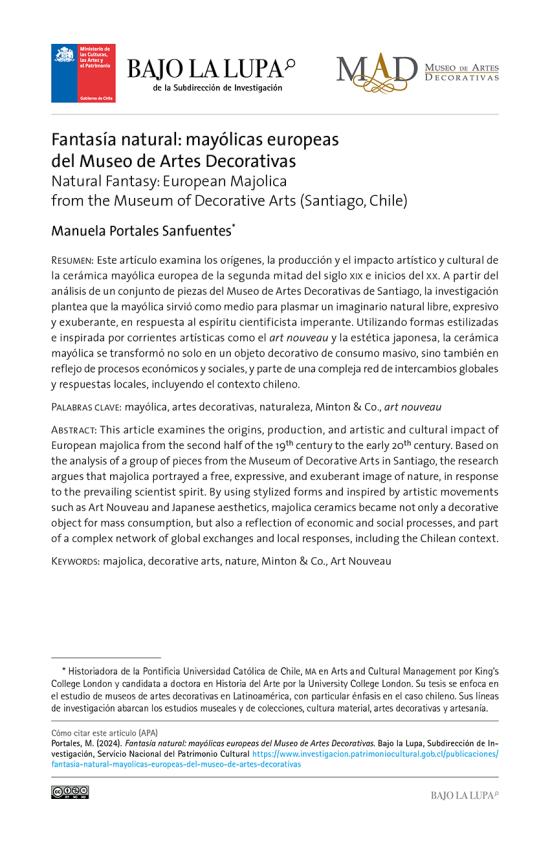Título Inglés / Original
Natural Fantasy: European Majolica from the Museum of Decorative Arts (Santiago, Chile)
Institución
Museo de Artes Decorativas
Autores
Manuela Portales Sanfuentes
Resumen en inglés (Abstract)
This article examines the origins, production, and artistic and cultural impact of
European majolica from the second half of the 19th century to the early 20th century. Based on
the analysis of a group of pieces from the Museum of Decorative Arts in Santiago, the research
argues that majolica portrayed a free, expressive, and exuberant image of nature, in response
to the prevailing scientist spirit. By using stylized forms and inspired by artistic movements
such as Art Nouveau and Japanese aesthetics, majolica ceramics became not only a decorative
object for mass consumption, but also a reflection of economic and social processes, and part
of a complex network of global exchanges and local responses, including the Chilean context.
European majolica from the second half of the 19th century to the early 20th century. Based on
the analysis of a group of pieces from the Museum of Decorative Arts in Santiago, the research
argues that majolica portrayed a free, expressive, and exuberant image of nature, in response
to the prevailing scientist spirit. By using stylized forms and inspired by artistic movements
such as Art Nouveau and Japanese aesthetics, majolica ceramics became not only a decorative
object for mass consumption, but also a reflection of economic and social processes, and part
of a complex network of global exchanges and local responses, including the Chilean context.
Resumen en español
Este artículo examina los orígenes, la producción y el impacto artístico y cultural de
la cerámica mayólica europea de la segunda mitad del siglo XIX e inicios del XX. A partir del
análisis de un conjunto de piezas del Museo de Artes Decorativas de Santiago, la investigación
plantea que la mayólica sirvió como medio para plasmar un imaginario natural libre, expresivo
y exuberante, en respuesta al espíritu cientificista imperante. Utilizando formas estilizadas
e inspirada por corrientes artísticas como el art nouveau y la estética japonesa, la cerámica
mayólica se transformó no solo en un objeto decorativo de consumo masivo, sino también en
reflejo de procesos económicos y sociales, y parte de una compleja red de intercambios globales
y respuestas locales, incluyendo el contexto chileno.
la cerámica mayólica europea de la segunda mitad del siglo XIX e inicios del XX. A partir del
análisis de un conjunto de piezas del Museo de Artes Decorativas de Santiago, la investigación
plantea que la mayólica sirvió como medio para plasmar un imaginario natural libre, expresivo
y exuberante, en respuesta al espíritu cientificista imperante. Utilizando formas estilizadas
e inspirada por corrientes artísticas como el art nouveau y la estética japonesa, la cerámica
mayólica se transformó no solo en un objeto decorativo de consumo masivo, sino también en
reflejo de procesos económicos y sociales, y parte de una compleja red de intercambios globales
y respuestas locales, incluyendo el contexto chileno.

Palabras claves
Mayólicas
Artes decorativas
Naturaleza
Minton & Co.
Art nouveau
Fecha de publicación
Año 2024

